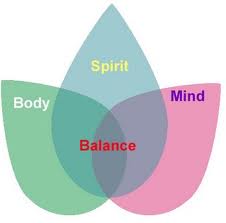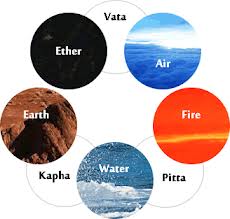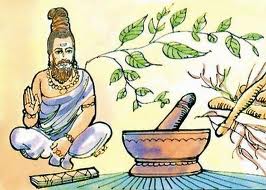BALANCE OF BODY AND MIND
February 25, 2013 by admin
Filed under An Introduction to Ayurveda
Ayurveda is a science of life based on the Vedas, the Hindu books of knowledge and wisdom. Ayurveda was introduced for about five thousand years old. Ayurveda is perhaps the most complete system of living, embracing not only medicine, but also philosophy, psychology, lifestyle and health.
 Ayurveda is based on the idea that the universe is composed of five basic elements of nature :Ether(space) , Air, Fire, Water and Earth, known as the Panchamahabhutas. The panchamabhutas combine to form the three vital energies, the doshas known as Vatta, Pitta, and Kapha. The mix of the three doshas in each of us, an inherited trait, determines our physical constitution called prakriti.
Ayurveda is based on the idea that the universe is composed of five basic elements of nature :Ether(space) , Air, Fire, Water and Earth, known as the Panchamahabhutas. The panchamabhutas combine to form the three vital energies, the doshas known as Vatta, Pitta, and Kapha. The mix of the three doshas in each of us, an inherited trait, determines our physical constitution called prakriti.
- Vata, pertaining to air and ether elements, is responsible for physical and mental movement, circulation, respiration and elimination.
- Pitta, pertaining to fire and water elements, is responsible for physical and mental digestion and metabolism.
- Kapha, pertaining to earth and water elements, is responsible for tissue growth and regeneration, physical and mental lubrication, structure, growth, immunity, stability and protection.
Each Dosha has an effect on the other. While one personality may reflect the prominence of one Dosha rather than another, the ideal for a balanced mind body state is where all three are working harmoniously together in a state of dynamic equilibrium
Methodology adopted in Ayurveda
Ayurveda is a holistic system of medicine that aims to balance the body, mind and spirit for optimum performance of a person and prevention and treatment of disease. Several problems such as headaches, hair loss and weight gain can be cured with this system of medicine. To achieve balance of mind and body, ayurveda recommends a proper diet, exercise and seasonal activities.
Follow Ayurvedic Diet
To do this you will have to establish your dosha typethat depends on your mind and body type. This can guide you on the foods that you should consume and the foods that you should avoid. Following an ayurvedic diet usually does not cost more than you would normally spend on groceries. It is a practical solution which requires discipline .
Practice Yoga
Regular practice of yoga along with a nutritious ayurvedic diet will do wonders for you. You will surely notice improvement in your awareness, physical health, mental stability and your ability to deal with stress. Yoga is considered good for spiritual growth as well. You can take the assistance of your instructor for determining selection of asanas.
Meditate for Balance
Ayurveda encourages meditation as it has several benefits. It clears your mind and improves your awareness. In addition it also improves your self-knowledge; an important factor that leads to a healthier mind and body, greater intelligence and stronger intuition.
Meditation can be classified into two types: daily and awareness meditation.
- Daily mediation: Meditation is done at a specific time daily for relaxation and spiritual growth.
- Awareness meditation: you are supposed to practice the simple art of being in the moment and it is practiced constantly in every activity that you do.
You will have to find the specific type of meditation that works for you. You can learn meditation by joining classes, reading books, CD’s or videos.
Mind Body Harmony
According to Ayurvedic principles, just as every individual has a unique fingerprint, the energy pattern of every individual varies from one another.
Ayurveda helps in bringing about balance of body, mind and consciousness, depending on individual constitution, by incorporating necessary lifestyle changes to maintain this balance.
The factors that disturb the balance of an individual could be external or internal. This would reflect by way of change in one’s constitution from their balanced state. These factors include physical and emotional stress, diet, weather change, work, family relationships and physical trauma.
Ayurveda lays emphasis on prevention and promotes maintenance of health by adopting healthy lifestyle habits.
As it is rightly said….He who has health…….. has everything.
Let’s make Ayurveda a lifestyle… enjoy a balanced life!!
Buy AYURVEDA AND THE MIND : THE HEALING OF CONSCIOUSNESS New ed Edition from Flipkart.com
CORE PRINCIPLES OF AYURVEDA
September 13, 2012 by admin
Filed under An Introduction to Ayurveda
Ayurveda is the ancient Indian system of natural and holistic medicine. In Sanskrit, Ayurveda means “the science of life” .While allopathic medicine tends to focus on the management of disease, Ayurveda bestows us with the knowledge of how to prevent disease and how to eliminate its root cause if it does occur.
 The aim of Ayurveda is to prevent illness and enhance wellness.
The aim of Ayurveda is to prevent illness and enhance wellness.
The knowledge of Ayurveda was passed orally through a lineage of sages in India until it was collated into text more than five thousand years ago. The oldest known texts on Ayurveda are the Charaka Samhita, Sushruta Samhita, and the Ashtanga Hrudaya. These texts detail the affect that the five elements found in the cosmic system – Space, air, earth, water and fire – have on our individual system, and expound on the importance of keeping these elements balanced for a healthy and happy life.
According to Ayurveda, each person will be influenced by certain elements more than others. This is because of their prakriti, or natural constitution. Ayurveda categorizes the different constitutions into three different doshas:
- Vata dosha, in which the air and space elements dominate
- Pitta dosha, in which the fire and water elements dominate
- Kapha dosha, in which the earth and water elements dominate
The dosha affects not just the shape of one’s body but also bodily tendencies (like food preferences and digestion), and the temperament of one’s mind and emotions. For example, the earth element in people with Kapha dosha is evident in their solid, sturdy body type, their tendency for slower digestion, their strong memory, and their emotional steadiness.
Most people’s prakriti is made up of a combination of two doshas. For example, people who are “Pitta Kapha” will have the tendencies of both Pitta dosha and Kapha dosha with Pitta dominating.
By understanding the qualities of our natural constitution we are better able to do what is needed to keep ourselves in balance.
if we are experiencing disease, it means there is an imbalance in our doshas; bringing our system back into balance is the key to the cure. Ayurveda has an effective tool for the diagnosis of disease called nadi pareeksha, or pulse diagnosis. By placing their finger on your wrist, an Ayurvedic doctor can easily detect the imbalances in the body and prescribe an effective treatment.
Treatments usually come in one of two forms:
1) Panchakarma, a 5- pronged body purification program
If toxins in the body are abundant, then a cleansing process known as panchakarma is recommended to purge these unwanted toxins. This fivefold purification therapy is a classical form of treatment in ayurveda. These specialized procedures consist of the following:
- Therapeutic vomiting or emesis (Vaman)
- Purgation (Virechan)
- Enema (Basti)
- Elimination of toxins through the nose (Nasya)
- Bloodletting or detoxification of the blood (Rakta moksha)
2) Herbal medicines to balance the body
Ayurveda places great importance on one’s pathya, or lifestyle (eating habits and daily routine). Ayurveda also provides guidance on how to adjust our lifestyle based on the change of seasons
Holistic Health
Ayurveda`s focus on an individual`s holistic health rather than merely the physical body, is the most beneficial aspect of ayurvedic medicine. It works on the principle that a perfect health condition is achievable through the emotional integration in a person. Ayurveda provides us with a unique physical purification method called panchakarma and various ayurvedic herbal health remedies for mental and spiritual well-being.
A healthy person, as defined in Sushrut Samhita, one of the primary works on Ayurveda, is “he whose doshas are in balance, appetite is good, all tissues of the body and all natural urges are functioning properly, and whose mind, body and spirit are cheerful…”
The ultimate goal of ayurveda is to create a state of holistic health for the individual, to create, consequently, a healthy society and environment with its herbal health remedies. To attain this state ayurveda believes one`s life must move in harmony with nature`s rhythms and its laws. Because, ayurvedic medicine recognizes the human body is part of nature. The five great elements of the universe forms the three doshas of the human body, and a balance among the three doshas is necessary for the perfect working of the whole mechanism of body, mind and soul.
These holistic health benefits of ayurveda includes the physical, mental as well as the spiritual aspects of a person.
Physical Benefits
Noninvasive diagnostic ayurvedic treatments are beneficial for chronic patients. Ayurvedic medicine resorts to outward diagnosis of symptoms by studying a patients` habits -diet and daily life, pulse. Difficult diseases are managed effectively by these diagnostic methods.
Detoxification methods of ayurveda like panchakarma and other herbal health remedies, when applied wholly or singly, make the body more responsive to medicines and treatment. It hastens the healing process.
Various yogasanas prescribed by ayurveda help prevent the diseases from occurring and accumulating. Yogasanas achieve the twin purpose of strengthening body-parts such as bones, muscle and vital organs like heart, liver, stomach, intestine as well as keeping our blood circulation and psychological conditions strong and flexible.
Most importantly, a correct diet according to one`s dosha type, and well-regulated life (dinacharya) helps strengthen one`s natural immune system.
Psychological Benefits
Perhaps ayurveda is the first such medical systems who recognizes that all diseases are but the direct manifestation of one`s mental conditions. It says human mind consists three states or trigunas -sattva, rajas and tamas. Any disturbances in the equilibrium of the tri-gunas, manifest in physical illness according to the intensity or nature of the disturbances. In fact, the condition of body and mind are integral to the overall health of an individual.
When the mind is stressed the stress hormone cortisone is released by adrenal glands. The level of hormone released affects the total volume of the brain that is involved in memory forming, organizing, and storing. Stress also affects all our decision-making activities in every field of life.
Ayurveda stresses on four principles to maintain the balance and equanimity of the mind .They are:
- regulation in ahara (food habit),
- vihara (activities),
- nidra (sleeping habit) and
- maithuna (sexual habit)
The guidelines for an intelligently regulated diet and daily routine are now, accepted techniques for stress management.
Ayurvedic massages, inhalation of herbal (Aromatherapy) preparations, panchakarma (nasya) besides the much-tested yogasanas and meditation leave a calming effect on the nerves.
Spiritual Benefits
The balance of tri-doshas and tri-gunas is imperative in this regard, for the individual needs to remain in balance within itself and in harmony outside with the nature. Various advanced ayurvedic treatments were born out of a necessity to keep the mind and body in perfect shapes to pursue the path of self-realization. Each individual is believed to possess undefined measures of creative capability, which, ideally, need to be realized. To achieve this, ayurveda emphasizes that the individual has to experience its oneness with the universe.
The treatment methods, diet and lifestyle regimen in ayurveda are carefully planned to heal the body as well as enrich the mind and the soul of each different individual. So that each can improve from their own levels to the higher goal of realizing the full self-potential. It was with ayurveda that the unique longevity and rejuvenating method of rasayana was born for mankind to progress in the path of spirituality.
HISTORY OF AYURVEDA
September 13, 2012 by admin
Filed under An Introduction to Ayurveda
Ayurveda is a holistic system of medical science that integrates the mind, body and spirit .and is the oldest healing science which is almost 5000 years old. Ayurveda contains two Sanskrit words: Ayu which means life or lifespan and Veda meaning knowledge (The Science of Life). This system of medicine was shaped in the ancient lands of India
The true history of Ayurveda starts from the time of the Holy books, the Vedas. Ancient mythology contends that the concept and essence of Ayurveda was revealed by the creator of the world himself – Lord Brahma.
Before the advent of writing, the ancient wisdom of this healing system was a part of the spiritual tradition of the Sanatana Dharma (Universal Religion), or Vedic Religion. Veda Vyasa, the famous sage, shaktavesha avatar of Vishnu, put into writing the complete knowledge of Ayurveda, along with the more directly spiritual insights of self realization into a body of scriptural literature called the Vedas and the Vedic literatures.
There are four Vedas – books of spirituality which date back to about 5000 years. They preach the philosophy of life . They are:
- Rigveda
- Yajurveda
- Samaveda
- Atharvaveda
 The Rig Veda, is a compilation of verse on the nature of existence, is the oldest surviving book of any Indo-European language (3000 B.C.). The Rig Veda refers to the cosmology known as Sankhya which lies at the base of both Ayurveda and Yoga, contains verses on the nature of health and disease, pathogenesis and principles of treatment. There are discussions in the Rig Veda of the three dhosas: Vayu. Pitta and Kapha, and the use of herbs to heal the diseases of the mind and body and to foster longevity.
The Rig Veda, is a compilation of verse on the nature of existence, is the oldest surviving book of any Indo-European language (3000 B.C.). The Rig Veda refers to the cosmology known as Sankhya which lies at the base of both Ayurveda and Yoga, contains verses on the nature of health and disease, pathogenesis and principles of treatment. There are discussions in the Rig Veda of the three dhosas: Vayu. Pitta and Kapha, and the use of herbs to heal the diseases of the mind and body and to foster longevity.
The Atharva Veda lists the eight divisions of Ayurveda: Internal Medicine, Surgery of Head and Neck, Opthamology and Otorinolaryngology, Surgery, Toxicology, Psychiatry, Pediatrics, Gerontology or Science of Rejuvenation, and the Science of Fertility.
Ayurveda is the most ancient science of healing which enhances longevity. It has influenced many of the older traditional methods of healing including Tibetan, Chinese and Greek medicine. Hence, Ayurveda is considered by many as the ‘mother of healing.’
The hymns, the mantras and the medical information contained in the Vedas were contributions of Rishis and munis or sages, over a period of time. Many of these sages were learned saints who devoted their life to understanding the world.
The Vedic Sages took the passages from the Vedic Scriptures relating to Ayurveda and compiled separate books dealing only with Ayurveda. One of these books, called the Atreya Samhita is the oldest medical book in the world! The Vedic Brahmanas were not only priests performing religious rites and ceremonies, they also became Vaidyas (physicians of Ayurveda). The sage-physician-surgeons of the time were the same sages or seers, deeply devoted holy people, who saw health as an integral part of spiritual life. It is said that they received their training of Ayurveda through direct cognition during meditation. In other words, the knowledge of the use of various methods of healing, prevention, longevity and surgery came through Divine revelation; there was no guessing or testing and harming animals. These revelations were transcribed from the oral tradition into book form, interspersed with the other aspects of life and spirituality.
What is fascinating is Ayurveda’s use of herbs, foods, aromas, gems, colors, yoga, mantras, lifestyle and surgery. Consequently Ayurveda grew into a respected and widely used system of healing in India. Around 1500 B.C., Ayurveda was delineated into eight specific branches of medicine.
There were two main schools of Ayurveda at that time. Atreya ( the school of physicians) and Dhanvantari ( the school of surgeons) . These two schools made Ayurveda a more scientifically verifiable and classifiable medical system.
The practical tenets of Ayurveda are divided into eight sections or branches. These sections include:
- Internal medicine,
- Surgery,
- Organic medicine,
- Pediatrics,
- Toxicology,
- Rejuvenating remedy,
- Aphrodisiac remedies and
- Spiritual healing.
These eight sections are called “Astanga Ayurveda“.
People from numerous countries came to Indian Ayurvedic schools to learn about this world medicine and the religious scriptures it sprang from. Learned men from China, Tibet, the Greeks, Romans, Egyptians, Afghanistanis, Persians, and more traveled to learn the complete wisdom and bring it back to their own countries. Ayurvedic texts were translated in Arabic and under physicians such as Avicenna and Razi Sempion, both of whom quoted Indian Ayurvedic texts, established Islamic medicine. This style became popular in Europe, and helped to form the foundation of the European tradition in medicine.
In 16th Century Europe, Paracelsus, who is known as the father of modem Western medicine, practiced and propagated a system of medicine which borrowed heavily from Ayurveda.
There are two main re-organizers of Ayurveda whose works are still existing in tact today – Charak and Sushrut. The third major treatise is called the Ashtanga Hridaya, which is a concise version of the works of Charak and Sushrut. Thus the three main Ayurvedic texts that are still used today are the Charak Samhita (compilation of the oldest book Atreya Samhita), Sushrut Samhita and the Ashtangha Hridaya Samhita. These books are believed to be over 1,200 years old. It is because these texts still contain the original and complete knowledge of this Ayurvedic world medicine, that Ayurveda is known today as the only complete medical system still in existence. Other forms of medicine from various cultures, although parallel are missing parts of the original information.
Decline and revival of Ayurveda
For a few centuries, the tradition of Ayurveda was dimmed due to the natural and human calamities and also by the invasion of foreign cultures into India. The sacred texts were either destroyed or stolen. However there were many ‘Vaidyas’ or doctors in India who managed to preserve some of the knowledge available in these Holy Scriptures. Divine plants that sustain long life and good health are now being rediscovered. Many renowned families of Vaidyas, who are specialized in certain branches of Ayurveda, have started functioning again in India. The Indian government began systematic research on Ayurvedic practices in 1969, and that work continues.
Before Ayurveda began its recent renewal in the West, it went through a period of decline in India when Western medical education became dominant during the era of British rule.
Ayurveda became a second-class option used primarily by traditional spiritual practitioners and the poor. After India gained its independence in 1947, Ayurveda gained ground and new schools began to be established. Today more than five hundred Ayurvedic companies and hospitals have opened in the last ten years, and several hundred schools have been established. Although Ayurveda remains a secondary system of health care in India, the trend toward complementary care is emerging, and Western and Ayurvedic physicians often work side by side.
Interest in Ayurveda in the West began in the mid 1970’s as Ayurvedic teachers from India began visiting the United States and Europe. By sharing their knowledge they have inspired a vast movement toward body-mind-spirit medicine. Today Ayurvedic colleges are opening throughout Europe, Australia, and the United States.
WHAT IS AYURVEDA
September 13, 2012 by admin
Filed under An Introduction to Ayurveda
Ayurveda is a science of life based on Vedas, the Hindu books of knowledge and wisdom. In Sanskrit , Ayurveda means “ Knowledge of life” . Ayurveda is a healthy-lifestyle system that people in India have used for more than 5,000 years. Ayurveda is perhaps the most complete system of living, embracing not only medicine, but also philosophy, psychology, lifestyle and health.

Ayurvedic medicine is holistic, which means viewing the body and mind as a whole.
According to Ayurveda, the five elements of nature (space, air, fire, water, earth) , also known as Panchabhutas combine in the body as three components (doshas) known as Vatta, Pitta and Kapha. These doshas ( life forces) relate closely to the basic elements of nature and to specific functions of the body. A balance of these doshas is thought to be required for optimal health.
Vatta is represented by Air and Space. It is considered the most powerful dosha because it controls very basic body processes such as cell division, the heart, breathing, muscle and joint movement ,discharge of waste and the mind . Vatta also controls anxiety, fear, pain and other functions of the nervous system.
Pitta is represented by Fire and Water. Pitta, which is thought to control such bodily functions as digestion, hormones, metabolism, intelligence and skin color. Pitta controls the emotions of anger, hate and jealousy.
Kapha is represented by Earth and Water . The physical structure of the body, growth of the body and the immune system are governed by Kapha. Emotional responses thought to be controlled by Kapha include calmness, forgiveness, love and greed.
The doshas, which are determined at the time of conception, also is reflected in an individual’s physical makeup and personality. A person with a Vatta makeup tends to have a small, thin build. The Pitta body style is more of a medium, muscular build. The Kapha appearance is usually bigger and well-developed. Most people are considered to have a combination of doshas, with one type of dosha usually being predominant.
The natural constitution is called the prakriti. The prakriti is a person’s unique combination of physical and psychological characteristics and the way the body functions to maintain health. It is influenced by such factors as digestion and how the body deals with waste products. The prakriti is believed to be unchanged over a person’s lifetime.
The most basic idea of Ayurveda is the concept of balance. We are healthy and happy when our doshas and our gunas are properly balanced. Most disease results from an imbalance of our doshas. To heal the disease, the Ayurvedic practitioner attempts through various treatments , dietary changes and exercise to restore the balance.
According to the ayurvedic philosophy, you can also use yoga, meditation or counseling to treat disease.The balanced body then heals itself.
How is Ayurveda used ?
People use ayurvedic practices to maintain health, reduce stress and improve flexibility, strength, and stamina. Researchers have found that yoga and meditation can be effective ways to treat diseases such as asthma, high blood pressure and arthritis.
Ayurveda stresses proper diet for maintaining good health and treating disease. Ayurvedic medicines are prescribed based on the person’s dosha type.
Researchers are studying the effects of ayurvedic herbal medicines on various long-term (chronic) illnesses.
Is it safe to use Ayurveda and follow its practices?
Ayurvedic practices such as yoga and meditation can be safe ways to promote health. If you have a long-term illness, you may be able to combine ayurveda with conventional medical treatment including counseling.
Ayurvedic herbal medicines, like conventional medicines, may cause side effects, trigger allergic reactions, or interact with other medicines or herbs you are taking. Some ayurvedic medicines may contain high levels of heavy metals.
A study in the recent times has indicated the presence of potentially harmful levels of lead and other heavy metals.
Always tell your doctor all your ailments and also the medicines you have been taking during that duration. Mention about all herbs and natural supplements. If you have already been on the course of ayurvedic medicine products, ask your doctor about screening for heavy metals.
To summarize, Ayurveda is a system that uses the body’s own defenses to restore and maintain health and happiness







